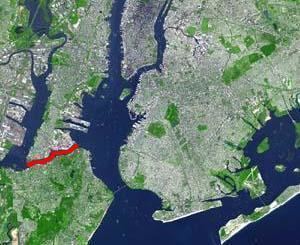 | ||
Similar | ||
The Kill Van Kull is a tidal strait between Staten Island, New York, and Bayonne, New Jersey, in the United States. Approximately 3 miles (4.8 km) long and 1,000 feet (305 m) wide, it connects Newark Bay with Upper New York Bay. The Robbins Reef Light marks the eastern end of the Kill, Bergen Point its western end. Spanned by the Bayonne Bridge, it is one of the most heavily travelled waterways in the Port of New York and New Jersey.
Contents
Map of Kill Van Kull, Staten Island, NY, USA
Historically it has been one of the most important channels for the commerce of the region, providing a passage for marine traffic between Upper New York Bay and the industrial towns of northeastern New Jersey. During the colonial era it played a significant role in travel between New York and the southern colonies, with passengers changing from ferries to coaches at Elizabethtown (now Elizabeth).
Since the final third of the 20th century, it has provided the principal access for oceangoing container ships to Port Newark-Elizabeth Marine Terminal, the busiest port facility in the eastern United States, and Howland Hook Marine Terminal. To accommodate the passage of ever-larger ships, the strait has required continued dredging and deepening. In many areas the sandy bottom has been excavated down to rock and now requires blasting. In addition, plans are underway to renovate the Bayonne Bridge so that larger container ships can travel the Kill Van Kull.
EtymologyEdit
Kill Van Kull translates as "channel from the pass" or "ridge". The name of the sister channel to the Kill Van Kull, the nearby Arthur Kill, is an anglicisation of achter kill, meaning "back channel", referring to its location "behind" Staten Island.
The name "Kill Van Kull" has its roots in the early 17th century during the Dutch colonial era, when the region was part of New Netherland. The naming of places by early explorers and settlers during the era often referred to a location in reference to other places based on its shape, topography, or other geographic qualities. The area around Newark Bay was called Achter Kol. The bay lies behind Bergen Hill, the emerging ridge of the Hudson Palisades, which begins on Bergen Neck, the peninsula between it and the Upper New York Bay. Behind or achter the ridge, was a col or passage to the interior. Kill comes from the Middle Dutch word kille, meaning "riverbed", "water channel", or "stream". During the British colonial era the bay was known as Cull Bay.
